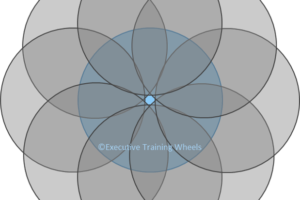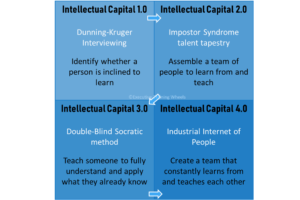Who I am and how I got Here
I went to a university with a strong math program, as I wanted to become a math professor. Unfortunately, I didn’t take it seriously enough and was kicked out. For the next full year, I did heavy steel work outdoors for 60+ hours per week. This instilled real work ethic in me. During that time, I was fortunate enough to have a fantastic boss who taught me about effective leadership simply by exemplifying it.
By the time I went back to school, I was determined to succeed in whatever path I chose. My first semester back, I earned a 4.00 GPA. I repeated that performance in other semesters, even when taking a 50% credit hour overload. While deciding what I wanted to do upon graduation, I considered business school, law school, an economics PhD program, or accepting a job offer from my internship at a defense contractor.
I took the GMAT to test the waters on the business school side, scored a 770, and decided to pursue that route. Shortly thereafter, I placed 3rd in an online business simulation competition for the nationally ranked MBA program at my alma mater, earning a 50% scholarship. That solidified my decision. I graduated from the University of Rochester with a 3.9 GPA, got married 2 weeks later, then started my full-time MBA program at Simon Business School.
Business school went by quickly. I met and worked with incredibly smart peers, and I learned as much from them as from my classes. I learned about professionalism from an operations manager at a bottling plant. I learned Excel keyboard shortcuts from a former back office investment bank employee. I learned about cultural influences in business from the 51% international student population of my graduating class. Through exposure to such a wide variety of perspectives, I became much more well-rounded. Of course, I also taught the things that I knew well- economics, finance, econometrics, and the local food scene.
My MBA internship turned into a part-time job that extended through my second year of the program, performing M&A due diligence and DCF modeling for REITs. By the time I graduated as salutatorian with another 3.9 GPA, I’d accepted an offer to work in corporate finance at a Fortune 500 specialty retailer.
Based on business needs at the time, I was placed in internal financial reporting, rather than the more desired treasury or capital teams. To this day, that is one of the luckiest things to happen to me in my career. For various reasons, I reported straight to a Director rather than a Manager for most of my first year. For months I worked one-on-one with the Senior VP of Finance in creating a massive budget presentation for the Board of Directors. Better still, every Monday night I got to spend hours with the CFO in his office poring over the weekly reports and identifying actionable items. In that first year as a Senior Analyst, I received more direct feedback and coaching from executives than many Directors get in several years.
The next year, I was in charge of building the Long-Term Vision model, the LTV. It was a behemoth Excel model for forecasting out 5 years of projections for every financial statement of every legal entity in the business. I worked largely self-directed for most of a year and made connections with finance and business leaders around the world. It was incredibly challenging and rewarding.
After the LTV, I was promoted to Manager of a more analytically-oriented team. Suddenly I had to both prove that I had the analytical chops needed and also learn how to manage a group of other Senior Analysts. One of the 3 Senior Analysts on the team I took over had previously put in his notice, one was promoted out of the team the day of my transition, and the other had a whopping 6 weeks of experience with the company. By necessity, I quickly learned how to keep my head above water while understaffed by delegating, prioritizing, and communicating. One of the simplest and hardest transitions for me was simply learning how to delegate, rather than attempting to do everything myself.
We learned together, pressed forward, and soon had a fully staffed team. I learned a tremendous amount about managing people, sometimes the hard way. I made it my mission to learn any leadership lessons as effectively as possible, since I wasn’t the only one to bear the burden of failures on that front. Drawing on my tutoring experience and lifelong passion for teaching, I learned how to be a good coach and develop people.
I’m pleased to say that I was the first FP&A Manager at that company to have 3 employees promoted to Manager within one year. In doing this, I became acquainted with one of the paradoxes of developing people- the increased likelihood of losing them to higher level positions elsewhere in the organization. Several years later I heard the phrase “exporter of talent in the organization,” liked it, and resolved to no longer concern myself with that particular paradox.
Eventually, on a particularly frustrating Winter day, I received a call from a recruiter looking for a Director in a warmer climate. I heard him out. It was for a “Director of Retail Data and Reporting” role for the retail arm of a vertically integrated multi-billion-dollar consumer goods company. It was the least inspiring title I’d ever heard, but it reported directly to the CEO of the retail company and had a lot of responsibility. I saw the opportunity to create an analytics team after fulfilling that role’s objectives, so after a few months of interviews I took it.
I started with no employees and buried with work. A few months in I was able to hire my first employee, and at the same time I took on two new supply chain projects. That first year, my wife and I were living in an apartment just down the street from the office, trying to learn the area. I ate most lunches at home with her, and I was always home for dinner. However, most nights I was either back in the office after dinner, or working from our living room.
To keep up with the supply chain work I had to do things with data that were completely foreign to me. I filled a notebook and countless whiteboards with algebra while devising algorithms to optimize distribution center capacity. I wrote appallingly inefficient code to rearrange, aggregate, and analyze ERP data. I ran that code every day hands-on for 2+ hours, for over 90 consecutive days. During those 3 months, no week broke below 80 hours worked. I’d finally found something harder than the steelwork from years prior.
I expanded my network at the office, got more help, and finally replaced the burnout-inducing process. In my second year, I made real progress in building the team and adding more value by transitioning it to a business intelligence team. We grew to 5 employees quickly, then 9 shortly thereafter. Atypical for a business intelligence team, 7 of the 9 were women. I was able to branch out more and help other areas, including teaching Excel skills and sharing everything I’d learned about supply chain best practices.
Shortly thereafter, I made the argument that a true analytics team was needed at the parent company level, and it should span across all verticals. The parent company’s executive team agreed, and a new team was born. A few months later, I finally gained success in building up the analytics team for the broader organization. I hired Senior Managers for Manufacturing, Supply Chain Planning, and Shared Services within a month of each other.
We quickly learned to work effectively together and accelerated the expansion of the team. We also completely changed how we worked with our overseas partners in the Data team. By the end of that year we had over 20 onshore members on the analytics team, yet no business vertical had more than 3 people dedicated to it. I was able to fund the entire expansion by reducing reliance on third party resources and tools.
The following year, my headcount remained fairly stable. We had some losses and additions, and at all times I kept multiple versions of the org chart alive for succession planning. We honed our interviewing approach to where we were able to do an incredible job selecting analytics and leadership talent. When we were forced to switch to open seating that year, I voluntarily gave up my office and sat in the open with the team. We created informal platforms for formal learning and encouraged team members to teach one another. The rate at which we grew capabilities was inspiring. The team dynamic and the rate at which team members’ skills and influence grew was our primary draw for attracting talent.
With people in place, I had more time to focus on process. I tracked our output and adjusted how we prioritized work. In 2018, we hit 10X ROI on total team payroll, with no paid analytics software. Self-service business intelligence went from near-zero to widespread adoption in one year. We revolutionized how assortment planning was conducted, and we changed long-held beliefs about staffing levels in stores.
In 2019 we broke well over 10X ROI on total department spend. I transitioned further away from hands-on and one-on-one coaching of Analysts to coaching the team’s leaders and ensuring they were coaching their people. We tightened relationships with several business areas. I laid out career-path coaching for every member of the team and ensured everyone had a clear development path.
Additionally, I expanded my practice of working directly with the owners, CEOs, and analytics leaders of many of our larger licensee operators to help them optimize their businesses. I also took on the wholesale sales operations team, and in 9 months the largest sales channel went from year-over-year decline to double-digit growth.
Toward the end of 2019 I gave up the sales operations team to take on the Data team. I laid out new strategies for the joint Data & Analytics team and proposed budgets with breakaway portions that would ensure the team could scale to the overall company’s financial needs throughout the year. That budget was approved in February 2020. In March 2020, I was let go due to business disruption from COVID-19.
The good news is the team I founded and developed lives on. I leave a legacy there that I can be proud of, where over the course of 5 years I directly hired 40 analytics professionals and added over $100M of incremental value. I also get to retain everything I learned from steeping myself in as many business areas as possible and from developing and working with teams of various natures.
Thankfully, my wife and I had sketched out plans 6 months prior to set up a leadership coaching and strategy consulting business for when the time was right. Right or not, the time is now. When I was younger, I wanted to be a math professor, for my passion in recognizing patterns and teaching others how to do the same. In college, I transferred that passion from math to economics and Finance. In business school, my favorite course was on evaluating executive talent. It was fascinating and complex material that has stuck with me. Throughout my career I explored and internalized every lesson I could on effective leadership and business strategy, often through the lens of finance or analytics. I am excited to bring all that experience together and share it with anyone who seeks to be a more effective leader.
Welcome to Executive Training Wheels. I hope you find the material here as fascinating and rewarding as I do.
I invite you to connect with me on LinkedIn here.



